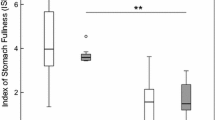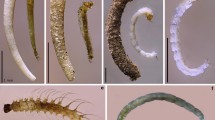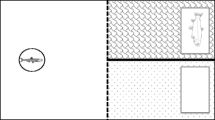Abstract
“Drifting” is known to subject aquatic invertebrates to intense predation by drift feeding fish. Consequently, interspecific variations in drifting behaviour could lead to differences in predation pressure between coexisting prey species. Predation being an important factor determining the success of invaders, differences in drift patterns could advantage either native or exotic invertebrates through differential predation by native fish predators. The exotic freshwater amphipod (Gammarus roeseli) has now largely colonized Western Europe where it is often found in sympatry with a native species (Gammarus pulex). Here we documented interspecific differences in drifting behaviour that might have favored the invader’s success through differential predation. Benthic and drifting amphipods were sampled three times at the same site to compare the proportion of each species within and between sample types (benthos or drift) across time. Compared with the benthos, where the invader (G. roeseli) was significantly less abundant than the native (G. pulex), G. roeseli was proportionally overrepresented in the drift but displayed a very different drifting pattern. While G. pulex drift rates remained roughly constant over a 24 h period, G. roeseli showed a marked diel periodicity with low diurnal and high nocturnal drift rates. Such drifting behaviour could procure this species with a competitive advantage regarding predation as most drift feeding fish are diurnal. As a result, the native appears more disadvantaged with respect to drift. This may partly explain the ability of G. roeseli to coexist with G. pulex in a habitat more suitable to the native.





Similar content being viewed by others
References
Andersen TH, Hansen HO, Iversen TM, Jacobsen D, Krojgaard L, Poulsen N (1992) Growth and feeding of 0+ brown trout (Salmo trutta) introduced to 2 small Danish streams. Arch Hydrobiol 125:339–346
Andersson KG, Brönmark C, Herrmann J, Malmquist B, Otto C, Sjörström P (1986) Presence of sculpins (Cottus gobio) reduces drift and activity of Gammarus pulex (Amphipoda). Hydrobiologia 133:209–215
Bakker TCM, Mazzi D, Zala S (1997) Parasite-induced changes in behaviour and colour make Gammarus pulex more prone to fish predation. Ecology 78:1098–1104
Bauer A, Trouvé S, Grégoire A, Bollache L, Cézilly F (2000) Differential influence of Pomphorhynchus laevis (Acanthocephala) on the behaviour of native and invader gammarid species. Int J Parasitol 30:1453–1457
Bethel WM, Holmes JC (1973) Altered evasive behaviour and responses to light in amphipods harbouring acanthocephalan cystacanths. J Parasitol 59:945–956
Bollache L, Gambade G, Cézilly F (2000) The influence of micro-habitat segregation on size-assortative pairing in Gammarus pulex (L.) (Crustacea: Amphipoda). Arch Hydrobiol 147:547–558
Bollache L, Devin S, Wattier R, Chovet M, Beisel JN, Moreteau JC, Rigaud T (2004) Rapid range extension of the Ponto-Caspian amphipod Dikerogammarus villosus in France: potential consequences. Arch Hydrobiol 160:57–66. doi:10.1127/0003-9136/2004/0160-0057
Bollache L, Kaldonski N, Troussard JP, Lagrue C, Rigaud T (2006) Spines and behaviour as defences against fish predators in an invasive freshwater amphipod. Anim Behav 72:627–633. doi:10.1016/j.anbehav.2005.11.020
Bollache L, Dick JTA, Farnsworth KD, Montgomery WI (2008) Comparison of the functional responses of invasive and native amphipods. Biol Lett 4:166–169. doi:10.1098/rsbl.2007.0554
Cornell HV, Lawton JH (1992) Species interactions, local and regional processes, and limits to the richness of ecological communities—a theoretical perspective. J Anim Ecol 61:1–12
Dahl J (1998) Effects of a benthivorous and a drift-feeding fish on a benthic stream assemblage. Oecologia 116:426–432
Dahl J, Greenberg L (1996) Effects of habitat structure on habitat use by Gammarus pulex in artificial streams. Fresh Biol 36:487–495
Dick JTA (1992) The nature and implications of differential predation between Gammarus pulex and G. duebeni celticus (Crustacea: Amphipoda). J Zool 227:171–183
Dick JTA (1996) Post-invasion amphipod communities of Lough Neagh, Northern Ireland: influences of habitat selection and mutual predation. J Anim Ecol 65:756–767
Dick JTA, Elwood RW (1992) Coexistence and exclusion among Gammarus species: behavioural avoidance of interspecific precopulation by male G. pulex (Amphipoda). Oikos 64:541–547
Dick JTA, Platvoet D (1996) Intraguild predation and species exclusions in amphipods: the interaction of behaviour, physiology and environment. Fresh Biol 36:375–383
Dick JTA, Platvoet D (2000) Invading predatory crustacean Dikerogammarus villosus eliminates both native and exotic species. Proc R Soc Lond B 267:977–983
Dick JTA, Irvine DE, Elwood RW (1990) Differential predation by males on moulted females may explain the competitive displacement of Gammarus duebeni by G. pulex (Amphipoda). Behav Ecol Sociobiol 26:41–45
Dick JTA, Montgomery WI, Elwood RW (1993) Replacement of the indigenous amphipod Gammarus duebeni celticus by the introduced G. pulex: differential cannibalism and mutual predation. J Anim Ecol 62:79–88
Dick JTA, Elwood RW, Montgomery WI (1995) The behavioural basis of a species replacement: differential aggression and predation between the introduced Gammarus pulex and the native G. duebeni celticus (Amphipoda). Behav Ecol Sociobiol 37:393–398
Dimond JB (1967) Evidence that drift of stream benthos is density related. Ecology 48:855–857
Elliott JM (1970) Diel changes in invertebrate drift and the food of trout Salmo trutta L. J Fish Biol 2:161–165
Elliott JM (2002a) A continuous study of the total drift of freshwater shrimps, Gammarus pulex, in a small stony stream in the English Lake District. Fresh Biol 47:75–86
Elliott JM (2002b) Time spent in the drift by downstream-dispersing invertebrates in a Lake District stream. Fresh Biol 47:97–106
Elliott JM (2002c) The drift distances and time spent in the drift by freshwater shrimps, Gammarus pulex, in a small stony stream, and their implications for the interpretation of downstream dispersal. Fresh Biol 47:1403–1417
Elliott JM (2003) A comparative study of the dispersal of 10 species of stream invertebrates. Fresh Biol 48:1652–1668
Elliott JM (2005) Day-night changes in the spatial distribution and habitat preferences of freshwater shrimps, Gammarus pulex, in a stony stream. Fresh Biol 50:552–566. doi:10.1111/j.1365-2427.2005.01345
Foeckler F, Schrimpff E (1985) Gammarids in streams of Northeastern Bavaria, F.R.G.II. The different hydrochemical habitats of Gammarus fossarum Koch, 1835 and Gammarus roeseli Gervais, 1835. Arch Hydrobiol 104:269–286
Giroux F, Ovidio M, Philippart JC, Baras E (2000) Relationship between the drift of macroinvertebrates and the activity of brown trout in a small stream. J Fish Biol 56:1248–1257
Henry KS, Danielopol DL (1999) Oxygen dependent habitat selection in surface and hyporheic environments by Gammarus roeseli Gervais (Crustacea: Amphipoda): experimental evidence. Hydrobiologia 390:51–60
Hieber M, Robinson CT, Uehlinger U (2003) Seasonal and diel patterns of invertebrate drift in different alpine stream types. Fresh Biol 48:1078–1092
Holt CS, Waters TF (1967) Effect of light intensity on drift of stream invertebrates. Ecology 48:225–234
Hughes DA (1970) Some factors affecting drift and upstream movements of Gammarus pulex. Ecology 51:301–305
Humphries S, Ruxton GD (2003) Estimation of intergenerational drift dispersal distances and mortality risk for aquatic macroinvertebrates. Limnol Oceanogr 48:2117–2124
Janetzky W (1994) Ditribution of the genus Gammarus (Amphipoda: Gammaridae) in the River Hunte and its tributaries (Lower Saxony, northern Germany). Hydrobiologia 294:23–32
Jazdzewski K, Roux AL (1988) Biogéographie de Gammarus roeseli Gervais en Europe, en particulier répartition en France et en Pologne. Crustaceana 13:272–277
Jazdzewski K, Konopacka A, Grabowski M (2004) Recent drastic changes in the gammarid fauna (Crustacea, Amphipoda) of the Vistula River deltaic system in Poland caused by alien invaders. Divers Distrib 10:81–87
Jenkins TM, Feldmuth CR, Elliott GV (1970) Feeding of rainbow trout (Salmo gairdneri) in relation to abundance of drifting organisms in a mountain stream. J Fish Res Board Can 27:2356–2361
Kaldonski N, Perrot-Minnot MJ, Cézilly F (2007) Differential influence of two acanthocephalan parasites on the anti-predator behaviour of their intermediate host. Anim Behav 74:1311–1317. doi:10.1016/j.anbehav.2007.02.027
Kaldonski N, Lagrue C, Motreuil S, Rigaud T, Bollache L (2008) Habitat segregation mediates predation by the benthic fish Cottus gobio on the exotic amphipod species Gammarus roeseli. Naturwissenschaften 9:839–844. doi:10.1007/s00114-008-0392-x
Karaman GS, Pinkster S (1977) Freshwater Gammarus species from Europe, North Africa and adjacent regions of Asia (Crustacea–Amphipoda). Bijdr Dierkd 47:1–97
Kestrup AM, Ricciardi A (2009) Environmental heterogeneity limits the local dominance of an invasive freshwater crustacean. Biol Invasions 11:2095–2105. doi:10.1007/s10530-009-9490-8
Kinzler W, Maier G (2003) Asymmetry in mutual predation: possible reason for the replacement of native gammarids by invasives. Arch Hydrobiol 157:473–481
Lagrue C, Kaldonski N, Perrot-Minnot MJ, Bollache L (2007) Modification of hosts’ behaviour by a parasite: field evidence for adaptive manipulation. Ecology 88:2839–2847
Lodge DM (1983) Biological invasions: lessons for ecology. Trends Ecol Evol 3:133–137
MacNeil C, Platvoet D (2005) The predatory impact of the freshwater invader Dikerogammarus villosus on native Gammarus pulex (Crustacea: Amphipoda); influences of differential microdistribution and food resources. J Zool 267:31–38. doi:10.1017/S0952836905007351
MacNeil C, Prenter J (2000) Differential microdistributions and interspecific interactions in coexisting native and introduced Gammarus spp. (Crustacea: Amphipoda). J Zool 251:377–384
MacNeil C, Dick JTA, Elwood RW (1997) The trophic ecology of freshwater Gammarus (Crustacea: Amphipoda); problems and perspectives concerning the functional feeding group concept. Biol Rev Camb Philos Soc 72:349–364
MacNeil C, Dick JTA, Elwood RW (1999) The dynamics of predation on Gammarus spp. (Crustacea: Amphipoda). Biol Rev 74:375–395
MacNeil C, Elwood RW, Dick JTA (2000) Factors influencing the importance of Gammarus spp. (Crustacea: Amphipoda) in riverine salmonid diets. Arch Hydrobiol 149:87–107
MacNeil C, Montgomery WI, Dick JTA, Elwood RW (2001) Factors influencing the distribution of native and introduced Gammarus spp. in Irish river systems. Arch Hydrobiol 151:353–368
MacNeil C, Bigsby E, Dick JTA, Hatcher MJ, Dunn AM (2003a) Differential physico-chemical tolerances and intraguild predation among native and invasive amphipods (Crustacea); a field study. Arch Hydrobiol 156:165–179
MacNeil C, Dick JTA, Hatcher MJ, Dunn AM (2003b) Differential drift and parasitism in invading and native Gammarus spp. (Crustacea: Amphipoda). Ecography 26:467–473
MacNeil C, Dick JTA, Hatcher MJ, Terry RS, Smith JE, Dunn AM (2003c) Parasite-mediated predation between native and invasive amphipods. Proc R Soc Lond B 270:1309–1314
McCahon CP, Maund SJ, Poulton MJ (1991) The effect of the acanthocephalan parasite (Pomphorhynchus laevis) on the drift of its intermediate host (Gammarus pulex). Fresh Biol 25:507–513
McGrath KE, Peeters ETHM, Beijer JAJ, Scheffer M (2007) Habitat-mediated cannibalism and microhabitat restriction in the stream invertebrate Gammarus pulex. Hydrobiologia 589:155–164. doi:10.1007/s10750-007-0731-5
Meijering MPD (1972) Experimental studies on drift and upstream movements of Gammarids in running waters. Arch Hydrobiol 70:133–205
Meijering MPD (1991) Lack of oxygen and low pH as limiting factors for Gammarus in Hessian brooks and rivers. Hydrobiologia 223:159–169
Müller K (1974) Stream drift as a chronobiological phenomenon in running water ecosystems. Annu Rev Ecol Syst 5:309–321
Noordhuis R, van Schie J, Jaarsma N (2009) Colonization patterns and impacts of the invasive amphipods Chelicorophium curvispinum and Dikerogammarus villosus in the IJsselmeer area, The Netherlands. Biol Invasions 11:2067–2084. doi:10.1007/s10530-009-9487-3
Otto C (1998) Factors affecting the disjunct distribution of amphipods along a North Swedish river. Oikos 83:21–28
Pinkster S, Scheepmaker M, Platvoet D, Broodbakker N (1992) Drastic changes in the amphipod fauna (Crustacea) of Dutch inland waters during the last 25 years. Bijdr Dierkd 61:193–204
Piscart C, Dick JTA, McCrisken D, MacNeil C (2009) Environmental mediation of intraguild predation between the freshwater invader Gammarus pulex and the native G. duebeni celticus. Biol Invasions 11:2141–2145. doi:10.1007/s10530-009-9497-1
Platvoet D, Dick JTA, MacNeil C, van Riel MC, van der Velde G (2009) Invader-invader interactions in relation to environmental heterogeneity leads to zonation of two amphipods, Dikerogammarus villosus (Sowinsky) and Gammarus tigrinus Sexton: amphipod pilot species project (AMPIS) report 6. Biol Invasions 11:2085–2093. doi:10.1007/s10530-009-9488-2
Pöckl M (2009) Success of the invasive Ponto-Caspian amphipod Dikerogammarus villosus by life history traits and reproductive capacity. Biol Invasions 11:2021–2041. doi:10.1007/s10530-009-9485-5
Pöckl M, Webb BW, Sutcliffe DW (2003) Life history and reproductive capacity of Gammarus fossarum and G. roeseli (Crustacea: Amphipoda) under naturally fluctuating water temperatures: a simulation study. Fresh Biol 48:53–66
Polis GA, Myers CA, Holt RD (1989) The ecology and evolution of intraguild predation: potential competitors that eat each other. Annu Rev Ecol Syst 20:297–330
Statzner B, Bittner A (1983) Nature and causes of migrations of Gammarus fossarum Koch (Amphipoda)—A filed study using a light intensifier for the detection of nocturnal activities. Crustaceana 44:271–291
Tain L, Perrot-Minnot MJ, Cézilly F (2006) Altered host behaviour and brain serotonergic activity caused by acanthocephalans: evidence for specificity. Proc R Soc Lond B 273:3039–3045. doi:10.1098/rspb.2006.3618
Toman MJ, Dall PC (1998) Respiratory levels and adaptations in four freshwater species of Gammarus (Crustacea: Amphipoda). Int Rev Hydrobiol 83:251–263
van der Velde G, Leuven RESW, Platvoet D, Bacela K, Huijbregts MAJ, Hendriks HWM, Kruijt D (2009) Environmental and morphological factors influencing predatory behaviour by invasive non-indigenous gammaridean species. Biol Invasions 11:2043–2054. doi:10.1007/s10530-009-9500-x
van Riel MC, Healy EP, van der Velde G, bij de Vaate A (2007) Interference competition among native and invader amphipods. Acta Oecologica 31:282–289. doi:10.1016/j.actao.2006.12.006
van Riel MC, ven der Velde G, bij de Vaate A (2009) Interference competition between alien invasive gammaridean species. Biol Invasions 11:2119–2132. doi:10.1007/s10530-009-9486-4
Ward PI (1986) A comparative field study of the breeding behaviour of a stream and a pond population of Gammarus pulex (Amphipoda). Oikos 46:29–36
Waters TF (1961) Standing crop and drift of stream bottom organisms. Ecology 42:532–537
Waters TF (1962) Diurnal periodicity in the drift of stream invertebrates. Ecology 43:316–320
Waters TF (1965) Interpretation of invertebrate drift in streams. Ecology 46:327–334
Waters TF (1966) Production rate, population density, and drift of a stream invertebrate. Ecology 47:595–604
Wijnhoven S, van Riel MC, van der Velde G (2003) Exotic and indigenous freshwater gammarid species: physiological tolerance to water temperature in relation to ionic content of the water. Aquat Ecol 37:151–158
Wooster D, Sih A (1995) A review of the drift and activity responses of stream prey to predator presence. Oikos 73:3–8
Acknowledgments
This study was funded by a grant from the Conseil Régional de Bourgogne. We thank Robert Poulin and other members of the Parasitology Research Group (University of Otago) for their help and comments on a previous version of the manuscript.
Author information
Authors and Affiliations
Corresponding author
Rights and permissions
About this article
Cite this article
Lagrue, C., Kaldonski, N., Motreuil, S. et al. Interspecific differences in drift behaviour between the native Gammarus pulex and the exotic Gammarus roeseli and possible implications for the invader’s success. Biol Invasions 13, 1409–1421 (2011). https://doi.org/10.1007/s10530-010-9899-0
Received:
Accepted:
Published:
Issue Date:
DOI: https://doi.org/10.1007/s10530-010-9899-0




